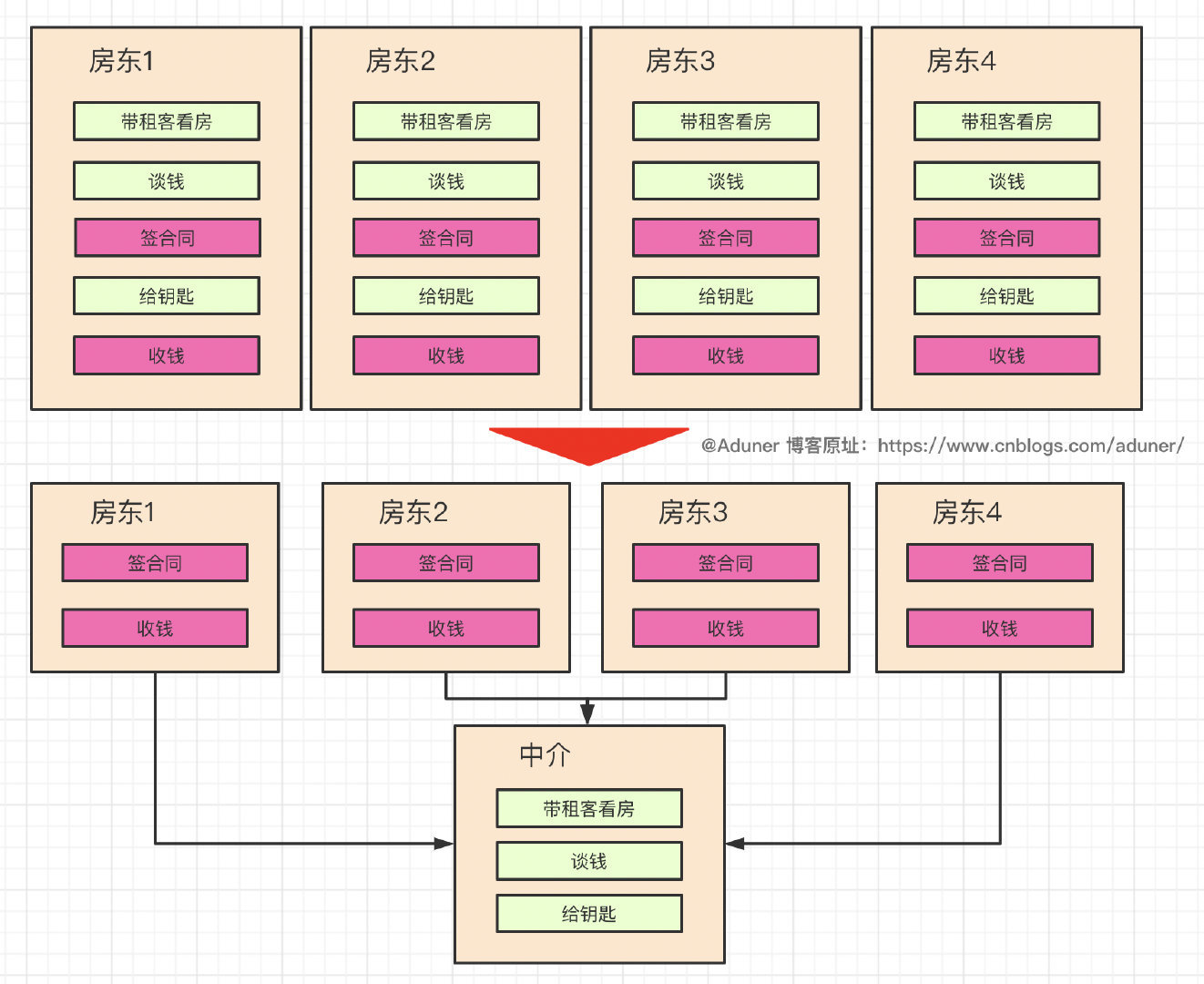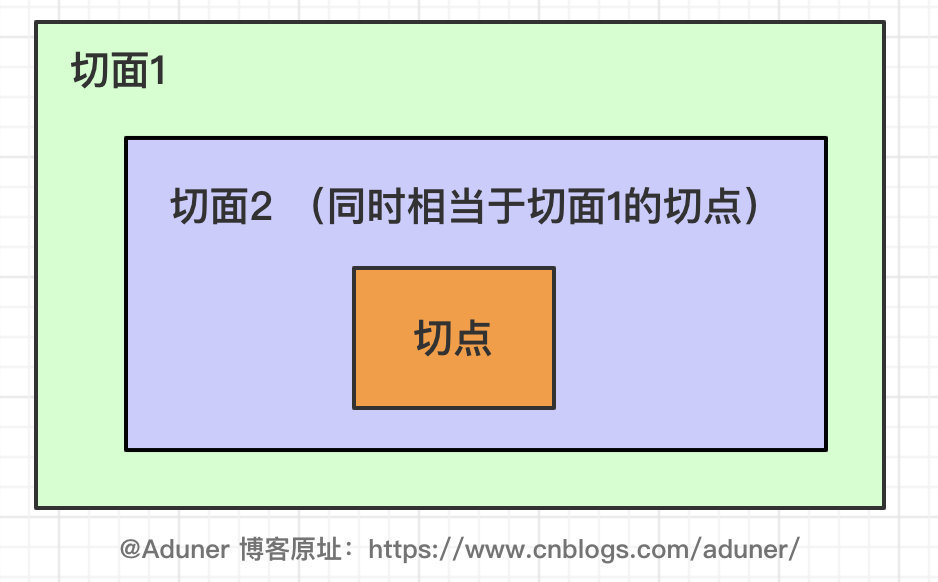轻松理解 Spring AOP
阅读本文之前建议先了解动态代理,可以参看我的另一篇博客 轻松理解 Java 静态代理/动态代理
Spring AOP 简介
Spring AOP 的基本概念
AOP (Aspect-Oriented Programming),即 面向切面编程, 它与 OOP (Object-Oriented Programming, 面向对象编程) 相辅相成, 提供了与 OOP 不同的抽象软件结构的视角.
在 OOP 中, 我们以类(class)作为我们的基本单元, 而 AOP 中的基本单元是 Aspect(切面)
AOP是 Spring 是最难理解的概念之一,同时也是非常重要的知识点,因为它真的很常用。
面向切面编程
在面向切面编程的思想里面,把功能分为两种
- 核心业务:登陆、注册、增、删、改、查、都叫核心业务
- 周边功能:日志、事务管理这些次要的为周边业务
在面向切面编程中,核心业务功能和周边功能是分别独立进行开发,两者不是耦合的;
然后把切面功能和核心业务功能 "编织" 在一起,这就叫AOP
AOP 的目的
AOP能够将那些与业务无关,却为业务模块所共同调用的逻辑或责任(例如事务处理、日志管理、权限控制等)封装起来,便于减少系统的重复代码,降低模块间的耦合度,并有利于未来的可拓展性和可维护性。
AOP 术语和流程
进一步了解AOP之前,我们先来看看AOP中使用到的一些术语,以及AOP运行的流程。
术语
- 连接点(join point):对应的是具体被拦截的对象,因为Spring只能支持方法,所以被拦截的对象往往就是指特定的方法。具体是指一个方法
- 切点(point cut):有时候,我们的切面不单单应用于单个方法,也可能是多个类的不同方法,这时,可以通过正则式和指示器的规则去定义,从而适配连接点。切点就是提供这样一个功能的概念。具体是指具体共同特征的多个方法。
- 通知(advice):它会根据约定织入流程中,需要弄明白它们在流程中的顺序和运行的条件,有这几种:
- 前置通知(before advice)
- 环绕通知(around advice)
- 后置通知(after advice)
- 异常通知(afterThrowing advice)
- 事后返回通知(afterReturning advice)
- 目标对象(target):即被代理的对象,通俗理解各个切点的所在的类就是目标对象。
- 引入(introduction):是指引入新的类和其方法,增强现有Bean的功能。
- 织入(weaving):它是一个通过动态代理技术,为原有服务对象生成代理对象,然后将与切点定义匹配的连接点拦截,并按约定将各类通知织入约定流程的过程。
- 切面(aspect):定义切点、各类通知和引入的内容,AOP将通过它的信息来增强Bean的功能或将对应的方法织入流程。
上述的描述还是比较抽象的,配合下面的流程讲解以及例子,应该充分掌握这些概念了。
流程
画了一张图,通过张图可以清晰的了解AOP的整个流程,以及上面各个术语的意义和关系。
图片的流程顺序基于Spring 5

五大通知执行顺序
不同版本的Spring是有一定差异的,使用时候要注意
-
Spring 4
- 正常情况:环绕前置 ==> @Before ==> 目标方法执行 ==> 环绕返回 ==> 环绕最终 ==> @After ==> @AfterReturning
- 异常情况:环绕前置 ==> @Before ==> 目标方法执行 ==> 环绕异常 ==> 环绕最终 ==> @After ==> @AfterThrowing
-
Spring 5.28
- 正常情况:环绕前置 ==> @Before ==> 目标方法执行 ==> @AfterReturning ==> @After ==> 环绕返回 ==> 环绕最终
- 异常情况:环绕前置 ==> @Before ==> 目标方法执行 ==> @AfterThrowing ==> @After ==> 环绕异常 ==> 环绕最终
例子
图例
举一个实际中的例子来说明一下方便理解:

房东的核心诉求其实就是签合同,收钱,浅绿部分都是次要的,交给中介就好。
不过有的人可能就有疑问了,让房东带着不是更好吗,租客沟通起来不是更轻松吗?为啥非要分成两部分呢?
那么请看下面这种情况

当我们有很多个房东的时候,中介的优势就体现出来了。代入到我们实际的业务中,AOP能够极大的减轻我们的开发工作,让关注点代码与业务代码分离!实现解藕!
实际的代码
用一个实际代码案例来感受一下
- 创建一个房东
@Component("landlord")
public class Landlord {
public void service() {
System.out.println("签合同");
System.out.println("收钱");
}
}
- 创建中介
@Component
@Aspect
class Broker {
@Before("execution(* pojo.Landlord.service())")
public void before(){
System.out.println("带租客看房");
System.out.println("谈钱");
}
@After("execution(* pojo.Landlord.service())")
public void after(){
System.out.println("给钥匙");
}
}
3.在 applicationContext.xml 中配置自动注入
<?xml version="1.0" encoding="UTF-8"?>
<beans xmlns="http://www.springframework.org/schema/beans"
xmlns:xsi="http://www.w3.org/2001/XMLSchema-instance"
xmlns:context="http://www.springframework.org/schema/context"
xmlns:aop="http://www.springframework.org/schema/aop"
xsi:schemaLocation="http://www.springframework.org/schema/beans
http://www.springframework.org/schema/beans/spring-beans.xsd http://www.springframework.org/schema/context http://www.springframework.org/schema/context/spring-context.xsd http://www.springframework.org/schema/aop http://www.springframework.org/schema/aop/spring-aop.xsd">
<context:component-scan base-package="aspect" />
<context:component-scan base-package="pojo" />
<aop:aspectj-autoproxy/>
</beans>
- 测试
public class Test {
public static void main(String[] args) {
ApplicationContext context =
new ClassPathXmlApplicationContext("applicationContext.xml");
Landlord landlord = (Landlord) context.getBean("landlord", Landlord.class);
landlord.service();
}
}
5.执行看到效果:
带租客看房
谈钱
签合同
收钱
给钥匙
这个例子中我们用到了@Before和@After两个注解,其实就是设置的前置通知和后置通知。
最后的结果似乎与我们之前图例中的顺序不同,给钥匙在收钱之后了,这个问题留到后面再解决,目前只需要简单感受一下aop的使用即可。
预告:这种情况下应该使用环绕通知来完成这个需求
使用 Spring AOP
使用注解开发AOP
目前使用注解的方式进行Spring开发才是主流,包括SpringBoot中,已经是全注解开发,所以我们采用@AspectJ的注解方式,重新实现一下上面的用例,来学习AOP的使用。
| 注解 | 说明 |
|---|---|
@Before |
前置通知,在连接点方法前调用 |
@Around |
环绕通知,它将覆盖原有方法,可以想象成前置+原方法+后置 |
@After |
后置通知,在连接点方法后调用 |
@AfterReturning |
返回通知,在连接点方法执行并正常返回后调用,要求连接点方法在执行过程中没有发生异常 |
@AfterThrowing |
异常通知,当连接点方法异常时调用 |
第一步:选择连接点
Spring 是方法级别的 AOP 框架,我们主要也是以某个类额某个方法作为连接点,另一种说法就是:选择哪一个类的哪一方法用以增强功能。
@Component
public class Landlord {
public void service() {
System.out.println("签合同");
System.out.println("收钱");
}
}
我们在这里就选择上述 Landlord 类中的 service() 方法作为连接点。
第二步:创建切面
选择好了连接点就可以创建切面了,我们可以把切面理解为一个拦截器,当程序运行到连接点的时候,被拦截下来,在开头加入了初始化的方法,在结尾也加入了销毁的方法而已,在 Spring 中只要使用 @Aspect 注解一个类,那么 Spring IoC 容器就会认为这是一个切面了:
@Component
@Aspect
class Broker {
@Before("execution(* com.aduner.demo03.pojo.Landlord.service())")
public void before(){
System.out.println("带租客看房");
System.out.println("谈钱");
}
@After("execution(* com.aduner.demo03.pojo.Landlord.service())")
public void after(){
System.out.println("给钥匙");
}
}
切面的类仍然是一个 Bean ,需要
@Component注解标注
在上面的注解中定义了 execution 的正则表达式,Spring会通过这个正则式去匹配、去确定对应的方法(连接点)是否启用切面编程
execution(* com.aduner.demo03.pojo.Landlord.service())
依次对这个表达式作出分析:
- execution:执行方法的时候会触发
*:任意返回类型的方法- com.aduner.demo03.pojo.Landlord:类的全限定名
- service():拦截的方法的名称
- 如果是service(*) 就是表示任意参数的service方法
第三步:定义切点
每一个注解都重复写了同一个正则式,这显然比较冗余。为了克服这个问题,Spring定义了切点(Pointcut)的概念,切点的作用就是向Spring描述哪些类的哪些方法需要启用AOP编程,这样可以有效的降低代码的复杂度,而且有利于维护的方便。
@Component
@Aspect
class Broker {
@Pointcut("execution(* com.aduner.demo03.pojo.Landlord.service())")
public void pointcut() {
}
@Before("pointcut()")
public void before() {
System.out.println("带租客看房");
System.out.println("谈钱");
}
@After("pointcut()")
public void after() {
System.out.println("给钥匙");
}
}
第四步:配置好config
@Configuration
@EnableAspectJAutoProxy
@ComponentScan(basePackages = "com.aduner.demo03.*",
excludeFilters = {@ComponentScan.Filter(classes = {Service.class})})
public class AppConfig {
}
第五步:测试 AOP
@Test
void testAspect(){
ApplicationContext ctx = new AnnotationConfigApplicationContext( AppConfig.class ) ;
Landlord landlord=ctx.getBean(Landlord.class);
landlord.service();
((ConfigurableApplicationContext)ctx).close();
}
结果
……
带租客看房
谈钱
签合同
收钱
给钥匙
……
环绕通知
现在我们来解决一下前面遗留的那个问题,收钱和给钥匙的问题。
我们需要的应该是给了钥匙之后再收钱,但是现在是反过来的。
要实现这个需求,用到环绕通知,这是 Spring AOP 中最强大的通知,集成了前置通知和后置通知。
环绕通知(Around)是所有通知中最为强大的通知,强大也意味着难以控制。一般而言,使用它的场景是在你需要大幅度修改原有目标对象的服务逻辑时,否则都尽量使用其他的通知。
环绕通知是一个取代原有目标对象方法的通知,当然它也提供了回调原有目标对象方法的能力。
- 我们先来修改一下Landlord
@Component
public class Landlord {
public void service(int steps) {
if (steps == 1) {
System.out.println("签合同");
} else if(steps==2){
System.out.println("收钱");
}
else {
System.out.println("签合同");
System.out.println("收钱");
}
}
}
我们将service添加一个参数,第一步签合同,第二部收钱,如果没有制定第一步或者第二步,就一起执行。
- 然后重新编写一下我们的切面
@Component
@Aspect
class Broker {
@Pointcut("execution(* com.aduner.demo03.pojo.Landlord.service(*))")
public void pointcut() {
}
@Around("pointcut()")
public void around(ProceedingJoinPoint joinPoint) {
System.out.println("带租客看房");
System.out.println("谈价格");
try {
// joinPoint.proceed(); 这样就是执行原方法
joinPoint.proceed(new Object[]{1}); //重新指定方法的参数
System.out.println("交钥匙");
joinPoint.proceed(new Object[]{2});
} catch (Throwable throwable) {
throwable.printStackTrace();
}
}
}
- 修改一下刚刚的测试类,给到一个初始参数
@Test
void testAspect(){
ApplicationContext ctx = new AnnotationConfigApplicationContext( AppConfig.class ) ;
Landlord landlord=ctx.getBean(Landlord.class);
landlord.service(0);
((ConfigurableApplicationContext)ctx).close();
}
运行!成功!
……
带租客看房
谈价格
签合同
交钥匙
收钱
……
ProceedingJoinPoint对象
注意到切面编写中Around里面try中的joinPoint.proceed()方法
ProceedingJoinPoint对象是JoinPoint的子接口,该对象只用在@Around的切面方法中,添加了以下两个方法。
Object proceed() throws Throwable //执行目标方法
Object proceed(Object[] var1) throws Throwable //传入的新的参数去执行目标方法
前面的例子中我们显示把房东的工作分为了两步,然后再环绕通知中重新赋予参数并调用了两次,在两次中间插入了中介的工作。
实际开发中,上面这样的写法其实又会造成新的耦合,而且还会造成其他通知的混乱(调用了两次方法,其实会让有些通知返回两次)。
当然这只是一个例子,为了帮助更好的理解环绕通知。
多个切面
Spring可以支持多个切面同时运行,如果刚好多个切面的切点相同,切面的运行顺序就是一个关键了。
默认情况下,切面的运行顺序是混乱的,如果需要指定切面的运行顺序,我们需要用到@Order注解
@Component
@Aspect
@Order(1)
public class FirstAspect {
……
}
--------------------
@Component
@Aspect
@Order(2)
public class SecondAspect {
……
}
@Order注解中的值就是切片的顺序,但是他们不是顺序执行的而是包含关系。

总结
- AOP的出现是为了对程序解耦,减少系统的重复代码,提高可拓展性和可维护性。
- 常见的应用场景有权限管理、缓存、记录跟踪、优化、校准、日志、事务等等等等……总之AOP的使用是非常常见的。
- 需要注意不同Spring版本之间的AOP通知顺序是有差别的。补充:Spring5.28为分界线。
- 环绕通知很灵活、强大,但是也就意味着很难控制,如非必要,优先使用其他通知来完成。
- 多切面作用同一个切点时候注意切片顺序。


